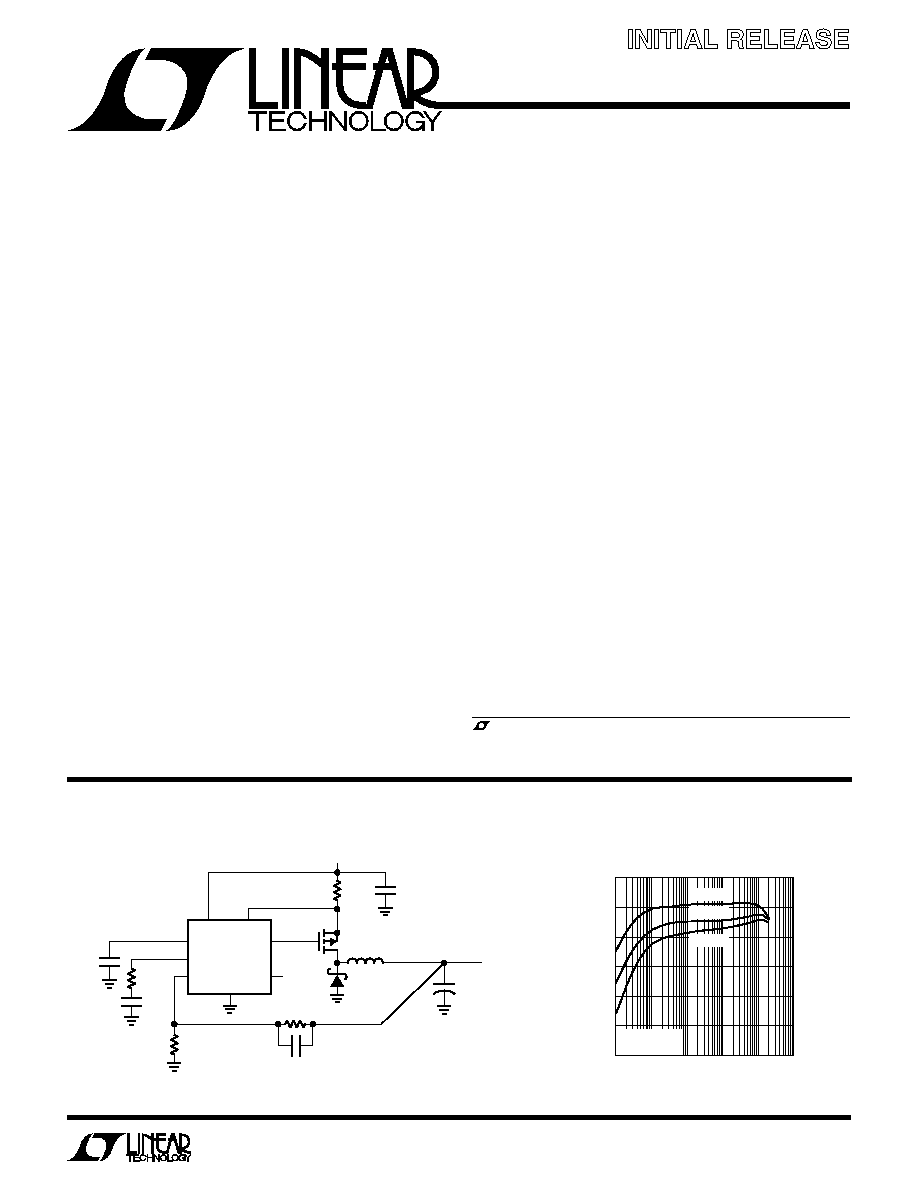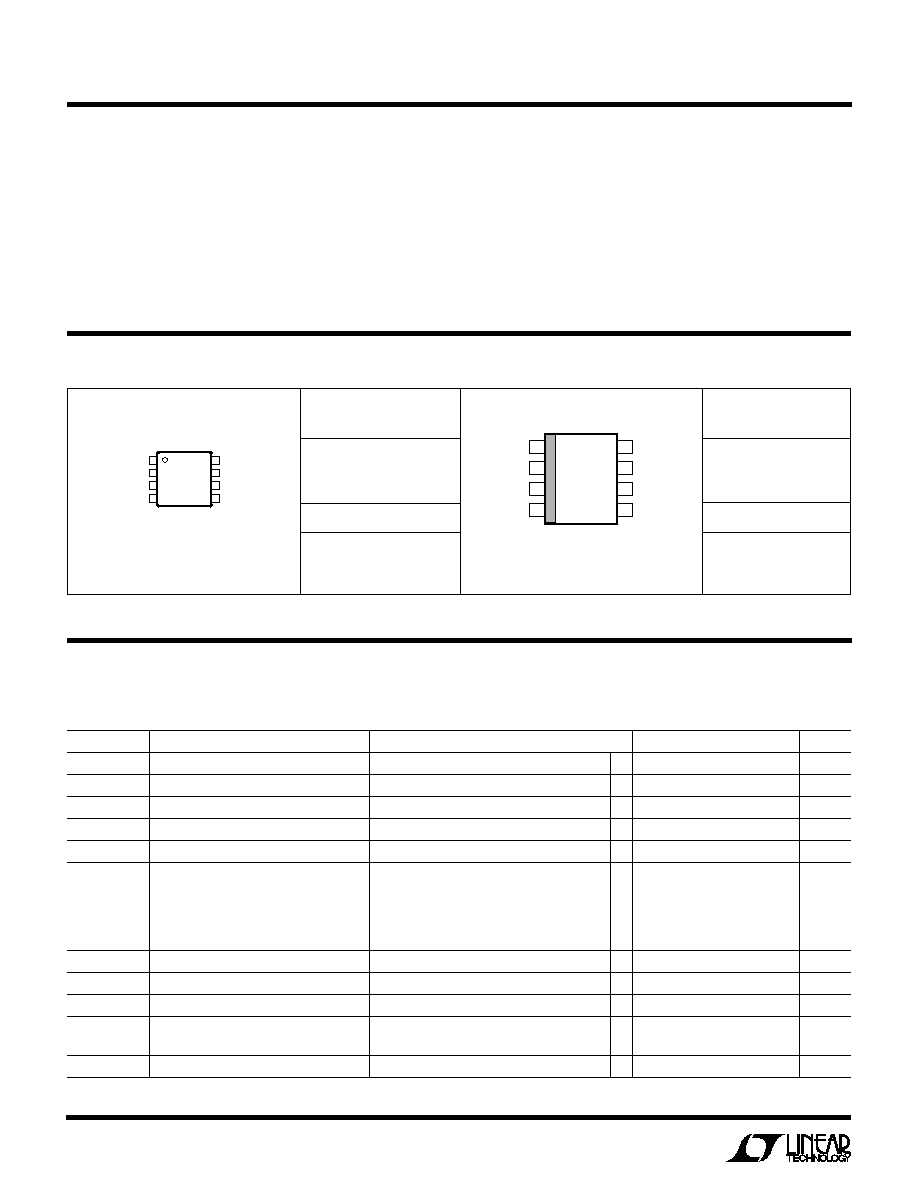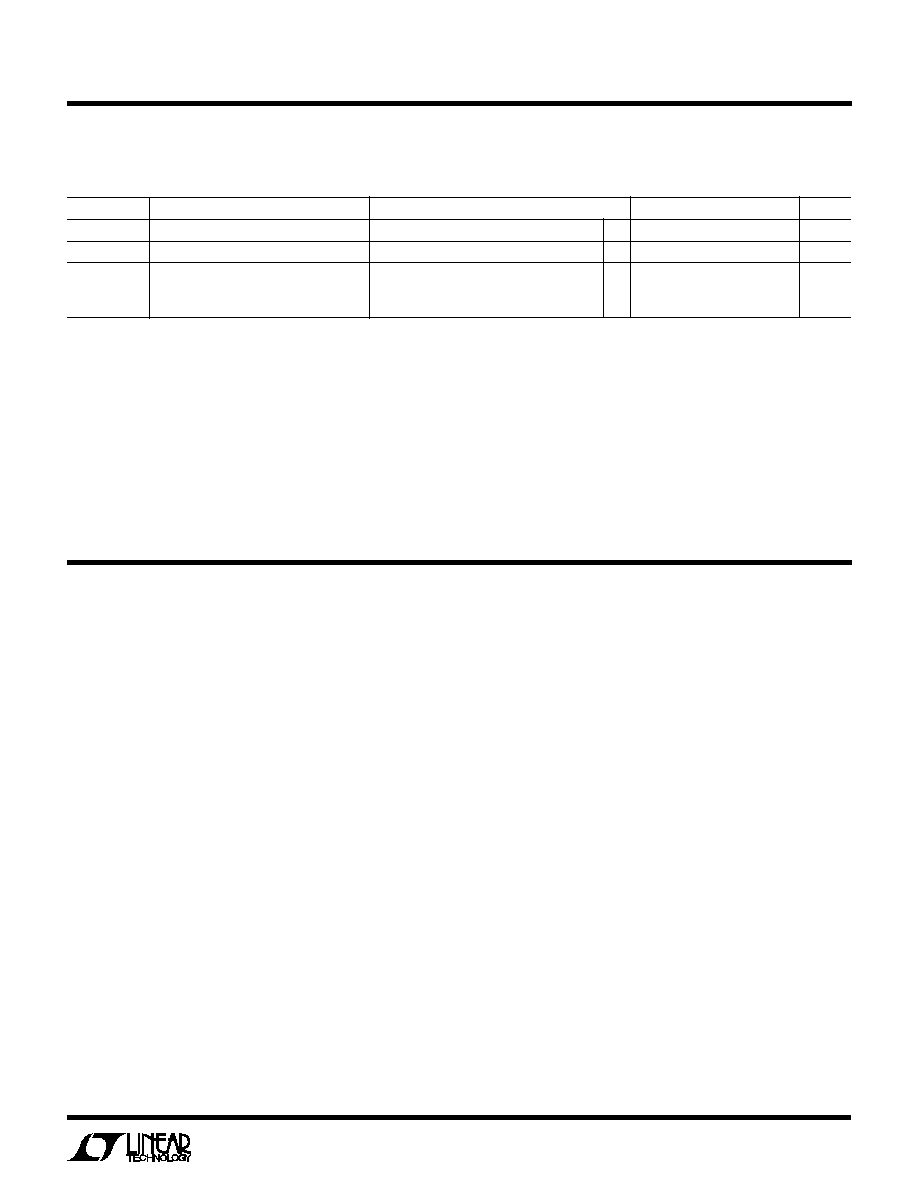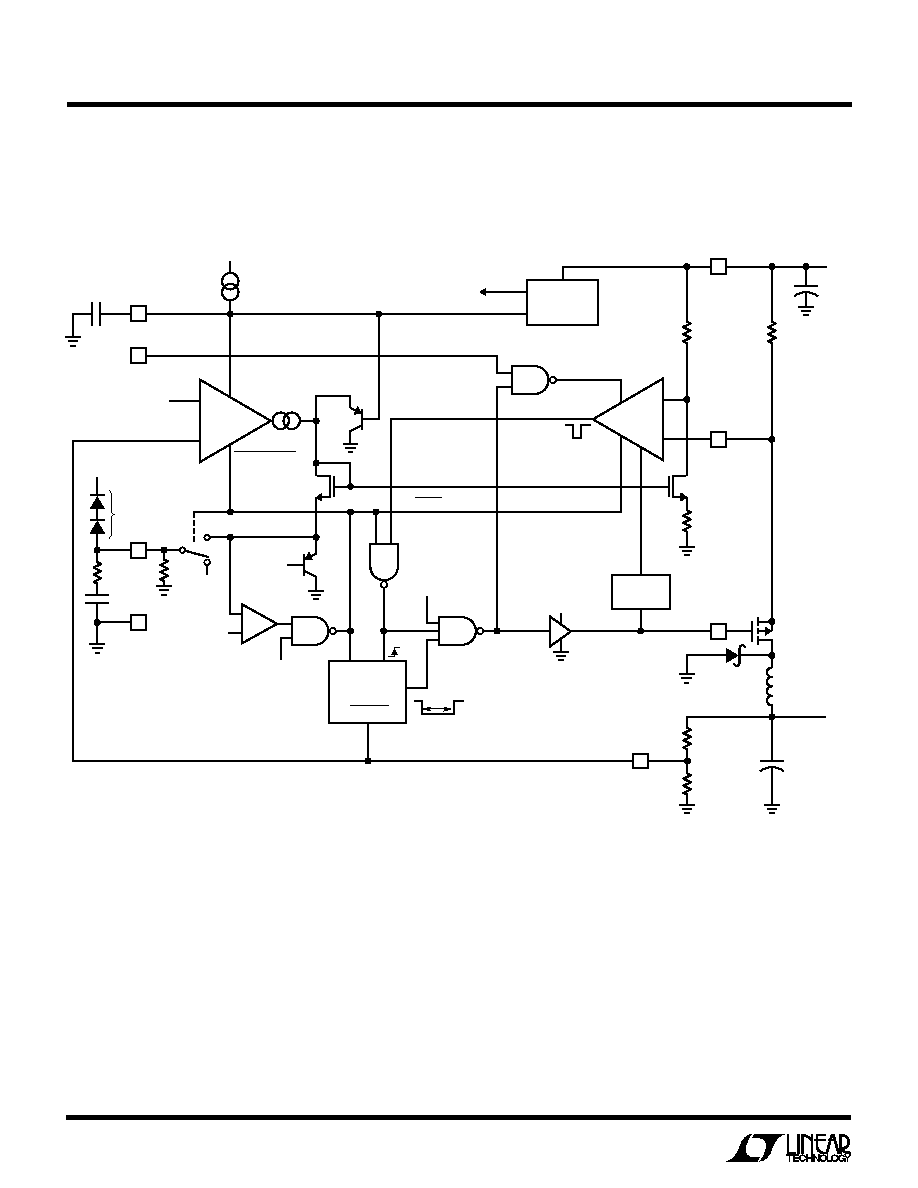Äîêóìåíòàöèÿ è îïèñàíèÿ www.docs.chipfind.ru

1
LTC1771
s
Very Low Standby Current: 10
µ
A
s
Available in Space-Saving 8-Lead MSOP Package
s
High Output Currents
s
Wide V
IN
Range: 2.8V to 20V Operation
s
V
OUT
Range: 1.23V to 18V
s
High Efficiency: Over 93% Possible
s
±
2% Output Accuracy
s
Very Low Dropout Operation: 100% Duty Cycle
s
Current Mode Operation for Excellent Line and
Load Transient Response
s
Defeatable Burst Mode
TM
Operation
s
Short-Circuit Protected
s
Optional Programmable Soft-Start
s
Micropower Shutdown: I
Q
= 2
µ
A
The LTC
®
1771 is a high efficiency current mode step-
down DC/DC controller that draws as little as 10
µ
A DC
supply current to regulate the output at no load while
maintaining high efficiency for loads up to several amps.
The LTC1771 drives an external P-channel power MOSFET
using a current mode, constant off-time architecture. An
external sense resistor is used to program the operating
current level. Current mode control provides short-circuit
protection, excellent transient response and controlled
start-up behavior. Burst Mode operation enables the
LTC1771 to maintain high efficiency down to extremely
low currents. Shutdown mode further reduces the supply
current to a mere 2
µ
A. For low noise applications, Burst
Mode operation can be easily disabled with the MODE pin.
Wide input supply range of 2.8V to 18V (20V maximum)
and 100% duty cycle operation for low dropout make the
LTC1771 ideal for a wide variety of battery-powered appli-
cations where maximizing battery life is important.
The LTC1771's availability in both 8-lead MSOP and SO
packages provides for a minimum area solution.
s
Cellular Telephones and Wireless Modems
s
1- to 4-Cell Lithium-Ion-Powered Applications
s
Portable Instruments
s
Battery-Powered Equipment
s
Battery Chargers
s
Scanners
Figure 1. High Efficiency Step-Down Converter
Low Quiescent Current
High Efficiency Step-Down
DC/DC Controller
February 2000
, LTC and LT are registered trademarks of Linear Technology Corporation.
Burst Mode is a trademark of Linear Technology Corporation.
RUN/SS
I
TH
V
FB
V
IN
V
IN
V
IN
4.5V TO 18V
R
C
10k
R
SENSE
0.05
R2
1.64M
1%
R1
1M
1%
M1
Si6447DQ
UPS5817
L1
15
µ
H
C
C
22OpF
5pF
10
µ
F
25V
CER
C
OUT
150
µ
F
6.3V
V
OUT
3.3V
2A
1771 F01
C
SS
0.01
µ
F
PGATE
MODE
LTC1771
GND
SENSE
+
LTC1771 Efficiency
LOAD CURRENT (mA)
EFFICIENCY (%)
100
90
80
70
60
50
40
0.1
1
100
1000
10000
1771 F01b
10
V
IN
= 5V
V
IN
= 10V
V
IN
= 15V
V
OUT
= 3.3V
R
SENSE
= 0.05
Final Electrical Specifications
Information furnished by Linear Technology Corporation is believed to be accurate and reliable.
However, no responsibility is assumed for its use. Linear Technology Corporation makes no represen-
tation that the interconnection of its circuits as described herein will not infringe on existing patent rights.
FEATURES
DESCRIPTIO
U
APPLICATIO S
U
TYPICAL APPLICATIO
U

2
LTC1771
The
q
denotes specifications which apply over the full operating temperature range, otherwise specifications are TA = 25
°
C.
V
IN
= 10V, V
RUN
= open unless otherwise specified.
LTC1771EMS8
T
JMAX
= 125
°
C,
JA
= 150
°
C/ W
ORDER PART
NUMBER
Input Supply Voltage (V
IN
)........................ 0.3V to 20V
Peak Driver Output Current < 10
µ
s (PGATE) ............. 1A
RUN/SS Voltage ........................... 0.3V to (V
IN
+ 0.3V)
MODE Voltage .......................................... 0.3V to 20V
I
TH
, V
FB
Voltage .......................................... 0.3V to 5V
SENSE Voltage (V
IN
> 12V)... (V
IN
12V) to (V
IN
+ 0.3V)
SENSE Voltage (V
IN
12V) .......... 0.3V to (V
IN
+ 0.3V)
(Note 1)
Consult factory for Military grade parts.
Junction Temperature (Note 2) ............................ 125
°
C
Operating Temperature Range (Note 3)
LTC1771E ......................................... 40
°
C to 85
°
C
LTC1771I ......................................... 40
°
C to 85
°
C
Storage Temperature Range ................. 65
°
C to 150
°
C
Lead Temperature (Soldering, 10 sec).................. 300
°
C
LTC1771ES8
LTC1771IS8
ORDER PART
NUMBER
RUN/SS
I
TH
V
FB
GND
1
2
3
4
8
7
6
5
MODE
SENSE
V
IN
PGATE
TOP VIEW
MS8 PACKAGE
8-LEAD PLASTIC MSOP
MS8 PART MARKING
TOP VIEW
MODE
SENSE
V
IN
PGATE
RUN/SS
I
TH
V
FB
GND
S8 PACKAGE
8-LEAD PLASTIC SO
1
2
3
4
8
7
6
5
T
JMAX
= 125
°
C,
JA
= 110
°
C/ W
S8 PART MARKING
1771
1771I
SYMBOL
PARAMETER
CONDITIONS
MIN
TYP
MAX
UNITS
V
FB
Feedback Voltage
(Note 5)
q
1.205
1.230
1.255
V
I
FB
Feedback Current
(Note 5)
q
1
10
nA
I
SUPPLY
No-Load Supply Current
V
IN
= 10V, I
LOAD
= 0 (Note 6)
10
µ
A
V
LINEREG
Reference Voltage Line Regulation
V
IN
= 5V to 15V (Note 5)
q
0.003
0.03
%/V
V
LOADREG
Output Voltage Load Regulation
I
TH
= 0.5V to 2V, Burst Disabled (Note 5)
q
0.25
1
%
I
Q
Input DC Supply Current
(Note 4)
Active Mode (PGATE = 0V)
V
IN
= 2.8V to 18V
150
235
µ
A
Sleep Mode (Note 6)
V
IN
= 2.8V to 18V, V
FB
= 1.5V
9
15
µ
A
Shutdown
V
IN
= 2.8V to 18V, V
RUN
= 0V
2
6
µ
A
Short Circuit
V
IN
= 2.8V to 18V, V
FB
= 0V
175
275
µ
A
V
SENSE(MAX)
Maximum Current Sense Threshold
V
FB
= V
REF
20mV
q
110
140
180
mV
V
SENSE(MIN)
Minimum Current Sense Threshold
V
FB
= V
REF
+ 10mV, Burst Disabled
25
mV
V
SENSE(SLEEP)
Sleep Current Sense Threshold
I
TH
= 1V
50
mV
t
OFF
Switch Off Time
V
FB
at Regulated Value
3.5
µ
s
V
FB
= 0V
70
µ
s
V
MODE
Mode Pin Threshold
V
MODE
Rising
q
0.5
1.3
2
V
LTKD
ABSOLUTE AXI U RATI GS
W
W
W
U
PACKAGE/ORDER I FOR ATIO
U
U
W
ELECTRICAL CHARACTERISTICS

3
LTC1771
Note 1: Absolute Maximum Ratings are those values beyond which the life
of a device may be impaired.
Note 2: T
J
is calculated from the ambient temperature T
A
and power
dissipation P
D
according to the following formulas:
LTC1771S8: T
J
= T
A
+ (P
D
)(110
°
C/W)
LTC1771MS8: T
J
= T
A
+ (P
D
)(150
°
C/W)
Note 3: The LTC1771E is guaranteed to meet performance specifications
from 0
°
C to 70
°
C. Specifications over the 40
°
C to 85
°
C operating
temperature range are assured by design, characterization and correlation
with statistical process controls. The LTC1771I is guaranteed and tested
over the 40
°
C to 85
°
C operating temperature range.
The
q
denotes specifications which apply over the full operating temperature range, otherwise specifications are TA = 25
°
C.
V
IN
= 10V, V
RUN
= open unless otherwise specified.
SYMBOL
PARAMETER
CONDITIONS
MIN
TYP
MAX
UNITS
V
RUN/SS
RUN/SS Pin Threshold
V
RUN/SS
Rising
q
0.5
1.0
2
V
I
RUN
Source Current
V
RUN
= 0V, V
IN
= 2.8V to 18V
0.3
1
3
µ
A
PGATE t
r
, t
f
PGATE Transition Time (Note 7)
Rise Time
C
LOAD
= 2000pF
80
ns
Fall Time
C
LOAD
= 2000pF
90
ns
Note 4: Dynamic supply current is higher due to the gate charge being
delivered at the switching frequency. See Applications Information.
Note 5: The LTC1771 is tested in a feedback loop that servos V
FB
to the
balance point for the error amplifier (V
ITH
= 1.23V).
Note 6: No-load supply current consists of sleep mode current (9
µ
A
typical) plus a small switching component necessary to overcome
Schottky diode leakage and feedback resistor current.
Note 7: t
r
and t
f
measured at 10% to 90% levels.
RUN/SS (Pin 1): The voltage level on this pin controls
shutdown/run mode (ground = shutdown, open/high =
run). Connecting an external capacitor to this pin provides
soft-start.
I
TH
(Pin 2): Error Amplifier Compensation Point. The
current comparator threshold increases with this control
voltage. Nominal voltage range for this pin is 0V to 3V.
V
FB
(Pin 3): Feedback of Output Voltage for Comparison
to Internal 1.23V Reference. An external resistive divider
across the output is returned to this pin.
GND (Pin 4): Ground Pin.
PGATE (Pin 5): High Current Gate Driver for External
P-Channel MOSFET Switch. Voltage swing is from ground
to V
IN
.
V
IN
(Pin 6): Main Input Voltage Supply Pin.
SENSE (Pin 7): Current Sense Input for Monitoring Switch
Current. Maximum switch current and Burst Mode
threshold is programmed with an external resistor be-
tween SENSE and V
IN
.
MODE (Pin 8): Burst Mode Enable/Disable Pin. Connect-
ing this pin to V
IN
(or above 2V) enables Burst Mode
operation, while connecting this pin to ground disables
Burst Mode operation. Do not leave floating.
ELECTRICAL CHARACTERISTICS
U
U
U
PI FU CTIO S

4
LTC1771
+
EA
+
C
ON
ON
+
C
SS
RUN/SS
V
IN
V
OUT
V
IN
1
MODE
MODE
READY
SLEEP
READY
250k
22k
R
SENSE
1.23V
1V
1V
2V
1
µ
A
(BURST ENABLE)
10% CURRENT
10% CURRENT
SOFT-START
8
V
IN
V
IN
V
OUT
L
C
IN
+
C
OUT
6
SENSE
7
SW
3.5
µ
s
1771 BD
5
V
FB
3
I
TH
R
C
C
C
*
*
OPTIONAL FOR FOLDBACK
CURRENT LIMITING
2
GND
4
+
B
ON TRIGGER
1.23V
REFERENCE
BLANKING
1-SHOT
STRETCH
FU
N
CTIO
N
AL BLOCK DIAGRA
U
U
W

5
LTC1771
(Refer to Functional Block Diagram)
Main Control Loop
The LTC1771 uses a constant off-time, current mode
step-down architecture. During normal operation, the
P-channel MOSFET is turned on at the beginning of each
cycle and turned off when the current comparator C
triggers the 1-shot timer. The external MOSFET switch
stays off for the 3.5
µ
s 1-shot duration and then turns back
on again to begin a new cycle. The peak inductor current
at which C triggers the 1-shot is controlled by the voltage
on Pin 3 (I
TH
), the output of the error amplifier EA. An
external resistive divider connected between V
OUT
and
ground allows EA to receive an output feedback voltage
V
FB
. When the load current increases, it causes a slight
decrease in V
FB
relative to the 1.23V reference, which in
turn causes the I
TH
voltage to increase until the average
inductor current matches the new load current.
The main control loop is shut down by pulling Pin 1
(RUN/SS) low. Releasing RUN/SS allows an internal 1
µ
A
current source to charge soft-start capacitor C
SS
. When
C
SS
reaches 1V, the main control loop is enabled with the
I
TH
voltage clamped at approximately 40% of its maxi-
mum value. As C
SS
continues to charge, I
TH
is gradually
released allowing normal operation to resume.
Burst Mode Operation
The LTC1771 provides outstanding low current efficiency
and ultralow no-load supply current by using Burst Mode
operation when the MODE pin is pulled above 2V. During
Burst Mode operation, short burst cycles of normal switch-
ing are followed by a longer idle period with the switch off
and the load current is supplied by the output capacitor.
During this idle period, only the minimum required cir-
cuitry--1.23V reference and error amp--are left on, and
the supply current is reduced to 9
µ
A. At no load, the output
capacitor is still discharged very slowly by leakage current
in the Schottky diode and feedback resistor current result-
ing in very low frequency burst cycles that add a few more
microamps to the supply current.
Burst Mode operation is provided by clamping the mini-
mum I
TH
voltage at 1V which represents about 25% of
maximum load current. If the load falls below this level, i.e.
the I
TH
voltage tries to fall below 1V, the burst comparator
B switches state signaling the LTC1771 to enter sleep
mode. During this time, EA is reduced to 10% of its normal
operating current and the external compensation capaci-
tor is disconnected and clamped to 1V so that the EA can
drive its output with the lower available current. As the load
discharges the output capacitor, the internal I
TH
voltage
increases. When it exceeds 1V the burst comparator exits
sleep mode, reconnects the external compensation com-
ponents to the error amplifier output, and returns EA to full
power along with the other necessary circuitry. This
scheme (patent pending) allows the EA to be reduced to
such a low operating current during sleep mode without
adding unacceptable delay to wake up the LTC1771 due to
the compensation capacitor on I
TH
required for stability in
normal operation.
Burst Mode operation can be disabled by pulling the
MODE pin to ground. In this mode of operation, the burst
comparator B is disabled and the I
TH
voltage allowed to go
all the way to 0V. The load can now be reduced to about 1%
of maximum load before the loop skips cycles to maintain
regulation. This mode provides a low noise output spec-
trum, useful for reducing both audio and RF interference,
at the expense of reduced efficiency at light loads.
Off-Time
The off-time duration is 3.5
µ
s when the feedback voltage
is close to the reference voltage; however, as the feedback
voltage drops, the off-time lengthens and reaches a maxi-
mum value of about 70
µ
s when V
FB
is zero. This ensures
that the inductor current has enough time to decay when
the reverse voltage across the inductor is low such as
during short circuit, thus protecting the MOSFET and
inductor.
OPERATIO
U




